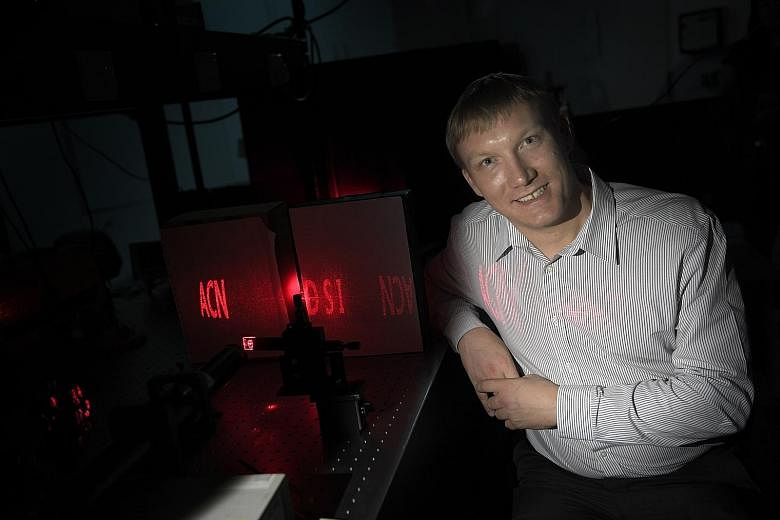For five years, a Russian scientist toiled in a Singapore laboratory in a bid to control light rays in a way never done before. The mission - to make 3D animations so high definition that the pixels cannot be seen even under a microscope.
This could pave the way for future devices such as smartphones to deliver super-clear, moving 3D images.
For his pioneering work, Dr Arseniy Kuznetsov, 37, who is from the Data Storage Institute (DSI) of the Agency for Science, Technology and Research (A*Star), was awarded a £350,000 (S$625,000) research prize by Britain's Institution of Engineering and Technology last December.
This is the first time the institute's annual A.F. Harvey Prize has been awarded to a scientist in Singapore.
Previous recipients hailed from the United States, Britain and Australia. The prize was set up in 2011 to support research in medical, microwave, laser and radar engineering.
The technology developed by Dr Kuznetsov could ultimately be part of everyday devices such as smartphones. "We're really working on the front edge of the science but, at the same time, it has a very targeted practical application," he said.
His research is expected to benefit current work in a number of areas, including virtual and augmented reality and 3D holographic displays.
Sir John O'Reilly, chair of the selection committee for the prize, said: "Dr Kuznetsov's research makes science fiction become science fact by overcoming current bottlenecks and limitations in developing switchable nanoantennas, which are likely to open doors for additional real-life applications."
Dr Kuznetsov manipulates light by passing it through tiny particles of silicon or other substances, arranged in neat rows and columns. The particles, or pixels, are as small as the wavelength of light itself - a few hundred nanometres across, or about a hundred times smaller than the diameter of human hair.
By varying the size of the particles, he can shift light waves slightly out of synchrony with one another, creating a hologram or 3D image.
Different-sized particles also resonate at different wavelengths, producing different colours.
This was not possible before Dr Kuznetsov's efforts. Previously, scientists were using particles of gold, which absorbed too much of the light and turned it into heat.
His eureka moment came in 2010 when he was peering through a microscope at a piece of silicon that had been etched by a powerful laser. He noticed that the laser had pulverised some of the silicon into fine particles, and this reflected light in many colours. It struck him that silicon and other materials could shine brighter than gold.
To date, Dr Kuznetsov's team has filed nine patent applications for a variety of devices based on the technology, such as lenses that can gather light much more effectively than conventional glass lenses, thus producing clearer images.
Other companies and research institutions around the world have been working on 3D displays too.
One of the most recent innovations was HoloFlex, a holographic smartphone developed by researchers in Canada last year. It uses a layer of small lenses to generate a 3D image whose resolution is much lower than that of images from Dr Kuznetsov's technology.
After graduating from Nizhniy Novgorod State University near Moscow in 2002, Dr Kuznetsov moved to Paris to do his doctorate in engineering. He worked as a research fellow in Germany before arriving in Singapore in 2011.
"In the institute where I was studying (in Russia), there were many good scientists from Soviet times... They were my teachers," he said.
"What I learnt was to be very critical of the work you do yourself and of the work others are presenting.
"Russian seminars are very intense all the time and I think this is the culture I try to bring here."
Ideas take shape during peaceful and quiet times too.
Dr Kuznetsov lives with his 38-year-old wife, who has a PhD in chemistry but has taken time off her career to look after their two children - a son, six, and daughter, 11.
They live near Bukit Timah Hill, where he takes regular evening hikes, listening to the insects. "When I'm walking, I'm actually thinking. During that time, I might get some ideas. That's a good time.
"And I can get ideas during the night when I sleep badly," he added with a laugh.
He also plays Beethoven, Chopin and Tchaikovsky pieces on the piano, which helps him to relax.
He points out that his daughter has taken a liking to mathematics.
"It's her favourite subject, same as mine when I was a schoolkid," he added.
For Dr Kuznetsov, the fun has just begun.
So far, his nanoparticle array displays only static images. He is now trying to make videos by changing the voltage applied to each particle, which alters the way it interacts with light over time.
He is in talks with companies about commercialising the technology, and plans to use the prize money along with other research grants to expand the team and "give it 100 per cent".
Dr Tan Yong Tsong, DSI's covering executive director, congratulated Dr Kuznetsov for receiving the prestigious award.
"I hope his achievement will inspire future generations of researchers in Singapore," he said.


